WULFEN, Franz Xavier.
(1728 – 1805)
Wulfen was born into a family descended from an old Swedish-Pomeranian noble family of Rügen Island in the Baltic. His father Christian Friedrich von Wulfen was a field marshal in the Austrian army, which afforded the family a comfortable life. He was educated in the Gymnasium in Kaschau in upper Hungary [now Košice, Czechoslovakia]. At the age of 17, Wulfen entered the Order of the Society of Jesus (Roman Catholic) in Vienna as a novice. During his training, he became known both for his diligence and his talents in mathematics and philosophy. In 1755 after his education was completed, Wulfen taught grammar of the classical languages in the Gymnasium of Görz [now Gorizia, Italy]. The following year he taught similar subjects at the Theresian Ritterakademie in Vienna. Subsequentially he gave lectures in the subjects of mathematics, logic and metaphysics in both Görz and Laibach [now Ljubljana, Serbia??]. In 1763 Wulfen was ordained a priest in the Jesuit order, and in 1769 he was transferred to Klagenfurt, Austria, where he spent the remainder of his life. There he became known for his benovolance and charity to those less fortunate than himself. Wulfen died in his 77th year from an infection of the lung.
The dramatic beauty of the mountains surrounding Klagenfurt frequently lured Wulfen to take long hikes along their slopes. Before coming to Klagenfurt, he had already established himself as a keen botanical observer by having published several papers on the subject. But it was during the excursions through the mountains that Wulfen conducted the studies into Austrian natural history that he is best remembered for today.
This research lead him to publish a series of well illustrated works on the insects, plants and minerals of the area. Through a long correspondance, Wulfen had become personally close to the Swede Carl Linné [q.v.]. As a consequence, in all these publications, Wulfen followed the theories and nomenclature of Linné. They are also publications that through out their text show the mark of an author in love with the subject he is describing. For the large number of new plant species discovered, a complete plant genus, Wulfenia (family Scrophulariae) was named in his honor. Wulfen's contributions to mineralogy are discussed below.
Biographical references: ADB: 44, 268-9. • Arnold, F., "Zur Erinnerung an Freiherr von Wulfen", Verhandlungs der zoologische-botanische Gesellschaft in Wien, 1882. • DBA: I 1397, 213-227; II 1432, 418-419. • Hunt Portrait Catalog: 444. • Klemun, M., "Arbeitsbedingungen eines Naturforschers im Kärnten des 18. Jahrhunderts am Beispiel Franz Xaver Wulfens", Carinthia I, 174, (1984), 357-74. • Kunitsch, M. von., Biographie des Franz Xaver Freyherrn von Wulfen, der weltweisheit Doctor, der erloschenen Gesellschaft Jesu, Mitglied ... Mit Portrait. Wien, Gassler, 1810, 35, [1] p., portrait. • Lambrecht & Quenstedt, Catalogus, 1938: 470. • Meixner, Mineralogischen Erforschung Kärntens, 1951: p. 17-8. • Mitchell, R.S., "Who's Who in Mineral Names. Franz Xaver von Wulfen (1728-1805)", Rocks and Minerals, 56, (1981), 163-4, portrait. • Nardo, G.D., Severio Wulfen illustre naturalista di Klagenfurt ... Nota. Venezia, [1868]. • Nau, R., "Der `Weisse Mann' vom Nassfeld der Botaniker Franz Xavier Wulfen", Die Kärntner Landsmannschaft, 158, (1968), 602-4. • Österreich Biographisches Lexikon: 2, 1290. • Pacher, W., "Franz Xaver Wulfen und die Anfänge der Naturbeschreibung der Kärntens", published in: Baum, W., editor. Kollegium, Lyzeum, Gymnasium. Vom "Collegium Sapientiae et Pietatis" zum Bundesgymnasium Völkermarkter Ring, Klagenfurt. Die Geschichte des ältesten Gymnasiums Österreichs. Klagenfurt, Kärntner Druck- und Vlgeges, 1991. • Poggendorff: 2, col. 1374. • Pritzel, Thesaurus Literaturæ Botanicæ, 1871-3. • Sarjeant, Geologists, Suppl. 1, 1986: 2, 898. • WBI. • Wurzbach, Biographisches Lexikon Österreich, 1856-91: 58, 265-9 [biblio.].

1. German, 1785.
Xavier Wulfens | Abhandlung | vom | kärnthnerischen Bleyspate. | [ornament] | [double rule] | Wein, | in der Johann Paul Kraußischen Buchhandlung, 1785.
4°: [A]-T4 )(4; 80l.; [1]-150, [10] p., 21 hand-colored plates. Page size: 300 x 225 mm. uncut.
Contents: [1-2], Title page, verso blank.; [3]-28, Introduction.; 29-150, Descriptions of figures on the plates.; [2 pgs], Blank.; [7 pgs], "Explicatio Figurarum."; [1 pg], Blank.; [At end], 21 hand-colored plates showing 46 figures.
Plates: Each of the 21 engraved plates is hand-colored and shows from one to several examples of the lead ore specimens Wulfen was collecting in the area surrounding Klagenfurt, Austria. The first plate is labeled "Tab. I.", while the remainder are labeled "T. 2" to "T. 21." The artistians signed only the first illustration: "Jo. Melling, Pinx. A. Amon sc.," the remainder of the plates are unsigned. Descriptions of the figures occur in the text of the book.
Rare. Wulfen's Abhandlung is one of the eighteenth centuries finest examples of a book containing hand-colored mineral illustrations. The many plates of this work, were probably all engraved by A. Anon [only the first is signed] from original paintings by Joseph Melling [see note below]. They each figure various specimens of the mineral then known as "gelbbleierz" [golden lead ore] which is the same mineral that in 1841 Wilhelm Haidinger scientifically described and named "Wulfenite," in honor of its first researcher. However, Wulfen did not confine himself to routine descriptions of "gelbbleierz." He is among the first to observe what is now recognized as paragenesis-the sequential order in which one mineral is deposited after another. He also assigns exact localities to every specimen and distinguishes wulfenite from different localities by means of the specimens physical characteristics such as color, luster, and crystal form.
Reprint, 1990: Xavier Wulfens | Abhandlung | vom | kärnthnerischen Bleyspate. | [ornament] | [double rule] | Wein, | in der Johann Paul Kraußischen Buchhandlung, 1785. [1]-150 p., 21 colored plates. The plates are bound opposite the page in the text that describes the figures; therefore, plates occur facing pages 30, 36, 46, 52, 54, 60, 62, 66, 70, 76, 80, 86, 92, 98, 110, 116, 118, 126, 130, 138 and 146.
Contents: [1-2], Title page, verso Text similar to: "Facsimile Reprint | by | Herbert P. Obodda | Short Hills, New Jersey, U.S.A. | August 20, 1990 | Copy Number One [-Twenty] | of a total of Twenty Copies."; [3]-28, Introduction.; 29-150, Descriptions of figures on the plates.
Numbered facsimile reprint photocopied on simulated hand-made paper by Herbert P. Obodda [see note below]. The plates are reproduced using color photocopy technology on the simulated paper as well. The edition was limited to 20 copies.
Joseph Melling. (Born: St. Avold, Lothr., Germany, 27 December 1724; Died: Karlsruhe, Austria, 8 November 1764) Austrian illustrator/engraver. Melling learned his trade as a pupil of the Academie Royale in Paris. He is today chiefly remembered for the paintings of a religious nature that embellish the ceilings and alters of churches throughout southern Germany and Austria.
Herbert Paul Obodda. (Born: New York City, New York, U.S.A., 1942; Died: ) American mineral dealer & book collector. One of the premier mineral dealers of the late 20th century and early 21st century, Obodda secured and sold many important specimens to institutions and private collectors, most notably those species originating from Morocco, Afganistan and Pakistan. He is also known for the superb library of books and manuscripts related to the sciences of mineralogy, crystallography and mining that he built over several decades. In the opinion of the compiler, this is one of the most significant collections of this type of literature ever accumulated by a single individual.
Bibliographical references: Allgemeine Deutsche Bibliothek: 78 no. 2, 452. • Allgemeine Literatur-Zeitung: 1 (1786), 634. • BL. • Freilich Sale Catalog: no. 564. • Gatterer, Mineralogischen Literatur, 1798-9: 2, 203. • LKG: XVI 172. • Meixner, Mineralogischen Erforschung Kärntens, 1951 [see pages 17-18]. (Melling) Thieme & Becker, Allgemeines Lexikon, 1907-50: 24, 366-7 [by K. Obser]. (Obodda) Personal communication [Herb Obodda, 1998].

2. Latin, 1791 [Latin transl.].
Xaverii Wulfen | De | Plumbo Spatoso | Carinthiaco. | [rule] | Ex | Germanico Idiomate | In Latinum | Transtulit | Josephus Eyerel. | Cum XXI. Tabulis Aeneis Coloratis. | [double rule] Vindobonae, | Apud Josephum Vincentium Degen. | 1791.
4°: A-N4 O2; 64l.; [1]-108 p., 21 hand-colored plates (some folding). Page size: 265 x 190 mm.
Contents: [1-2], Title page, verso blank.; [3]-108, Text.
Rare. Translation by Joseph Eyerel [see note below] of Abhandlung vom kärnthnerischen Bleyspate (Wien, 1785). In this edition, Wulfen's long introduction has been shortened by the translator. For illustrations, the work uses plates identical to those of the original edition, although in some cases the plates of this Latin edition have been either been folded or cropped to accomodate a smaller page size used in printing the text. This translation appears to have been published in a larger number of copies than the original 1785 edition because several copies of this translation are recorded in U.S. libraries while no copies of the German are listed.
Joseph Eyerel. (Born: Kaiserheim, Schwaben, Austria, 1745; Died: Vienna, Austria, 22 December 1821) Austrian physician. Eyerel established a medical practice in Vienna, where he became a friend and student to the famous Austrian physican Maximillian Stoll [1742-1787], to whose works he contributed commentary and editing. Eyerel translated many medical and natural history works from Latin, French and Italian into German.
Bibliographical references: BL. • Brunet: 5, 1483. • Freilich Sale Catalog: no. 565. • Gatterer, Mineralogischen Literatur, 1798-9: 2, 203. • NUC: 676, 196-7. (Eyerel) ADB: 6, 458. • Hirsch, Biographisches Lexikon, 1884-8: 2, 453. • Wurzbach, Biographisches Lexikon Österreich, 1856-91: 4, 121.
.